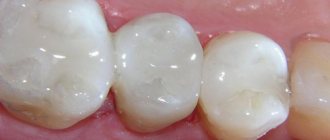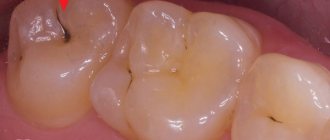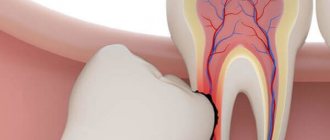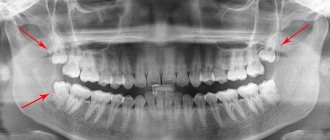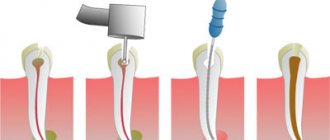Description of the pathological process
Its occurrence is provoked by cariogenic microorganisms, streptococci and lactobacilli (some types of them), which appear due to insufficient oral hygiene. Typically, bacteria begin to multiply in plaque, which is difficult to clean with a brush (most often on the back surface of the incisors). The carious area is difficult to notice on your own, especially in the early stages, since darkening begins to appear only when the area is already very widespread. That's why regular checkups with a dentist are so necessary - only he can carefully examine the entire oral cavity using a small mirror or take an x-ray.
Sometimes people wonder: “can children have caries on their front teeth?” Unfortunately, yes, it is also called “bottle” or “carob”.
It occurs in a small child if he often eats sweets (baby formula, cotton candy, candy, etc.). Such products contain a large amount of carbohydrates, which quickly destroy fragile tissues.
You also need to be careful with breast and cow's milk. It often sticks to the teeth in the upper jaw when children accidentally fall asleep with a bottle in their mouth. This product also contains sugar (albeit natural), and it quickly oxidizes and destroys the enamel. During sleep, this is especially dangerous due to the fact that the intensity of salivation, which is created for self-cleaning of the oral cavity, decreases. You can see the result of the defeat in the photo.
Stages of development of caries of anterior teeth
- White (chalky) spot stage. A dull white area appears on the surface of the tooth, which indicates thinning of the enamel.
- Stage of superficial caries. At this stage, microscopic holes and depressions appear on the enamel, which leads to increased tooth sensitivity. They react to hot, cold, sour, etc.
- Stage of intermediate caries. The disease affects the deeper layer – dentin. If the focus of caries is located on the back wall and is not visible, then the tooth becomes dark in color and the pain syndrome intensifies.
- Stage of severe deep caries. It is characterized by complete destruction of dentin, the angle of the cutting edge is destroyed, and a defect is formed in the root zone.
There is also atypical caries, which can start from the cutting edge. This type occurs when a combination of hereditary factors with increased consumption of foods rich in easily digestible carbohydrates. That's why dentists say that sweets are harmful!
Caries on the front teeth: what to do and why it occurs
In fact, there can be many reasons for its appearance:
- Hereditary predisposition. Our genes determine the thickness of the enamel. The thinner this tissue is from birth, the higher the likelihood of disease. But often the protection is weakened due to a person’s fault when he abuses hard, spicy, sour foods, carbonated drinks and sweets.
- Lack of hygiene procedures. Sometimes we are too lazy to carry them out thoroughly, so we either brush superficially, forgetting about hard-to-reach places, or we completely neglect this process. Because of this, plaque accumulates, and this is “fertile soil” for microbes.
- Poor nutrition. Vitamins and microelements are important for healthy teeth; without them, the enamel becomes thinner and changes its structure.
- Deformed jaw. It can be this way from birth or change during life from injuries or improper growth of the incisors. Most often, caries affects curved units: they are more difficult to clean, so plaque often accumulates on them. People with a narrow interdental gap or too wide fissures (grooves on the chewing surface) are also at risk.
- If a person works in a hazardous enterprise, he often unknowingly inhales air through his mouth containing chemicals that corrode enamel.
- Artificial injury. This applies most of all to seed lovers and seamstresses who bite threads instead of using scissors.
- Bad habits. Alcohol and nicotine not only thin the dental tissue, but also change its color, which makes their appearance unpleasant.
Treatment of anterior teeth
At the first stage, treatment consists of remineralization, during which the enamel is saturated with fluoride and calcium ions. This leads to its strengthening and stopping the development of the disease.
When treating superficial caries, grinding with polishers and discs is used. At this stage, it is still possible to do without a drill.
If the disease has affected the dentin, then using a drill, not only the softened affected tissues are excised, but also the pigmented areas, otherwise secondary caries may occur under the filling.
Treatment of incisors has its own characteristics.
Firstly, the front teeth are smaller in size than all the others, which requires high precision from the doctor.
Secondly, the enamel of the incisors is much thinner, and therefore the pain is much stronger.
Thirdly, the aesthetic component comes to the fore. It is necessary to accurately select the color of the filling and the degree of transparency.
If the outer surface of the teeth is severely damaged, it makes sense to install veneers on them: these are the thinnest linings made of ceramics or special dental polymers. To install them, a more gentle treatment of the tooth is used than for a crown. Fixation is carried out with a special low-allergenic glue.
If the incisor cannot be saved, after removal, prosthetics of the front tooth is performed. The prosthesis is made of ceramics or zirconium dioxide.
The price for treatment of front teeth depends on what stage of caries you come to the dentist for, so you shouldn’t put off a visit to the doctor until tomorrow.
Symptoms
You need to understand that the enamel on the incisors is very thin, so the disease develops on them much faster. Many people do not know what caries on the front teeth looks like initially. It begins with the appearance of a small white or yellowish spot. Further, the enamel becomes thinner and sensitivity increases: it becomes difficult to drink cold drinks or eat ice cream. Later, periodic pains of aching or throbbing nature appear. In the final stages, pulpitis (inflammation of a bundle of nerves and blood vessels) or periodontitis (damage to tissue around the root) develops.
It is best to go to the doctor at the first stage, so the treatment process will be easier, faster and more comfortable. But usually they do not pay attention to a minor formation - then the lesion begins to spread at high speed.
Is it possible to determine the onset of the disease yourself?
In most cases, it is not possible to notice the problem at an early stage of its development. Most often, caries occurs in hard-to-reach places (between the teeth or on their back surface).
But sometimes they show specific signals that there is trouble with the incisors:
- when there is a sharp change in temperature, short-term pain occurs;
- sometimes the uneven edges of a carious cavity can be felt tactilely, using the tongue;
- a specific odor appears from the mouth, especially in the morning before meals;
- a dark spot becomes noticeable.
It is important to understand that such signs are not always present, and only a doctor can determine the onset of the disease. It has all the necessary tools and devices for high-quality diagnostics. Therefore, you should not neglect a visit to the doctor and check in time whether everything is in order.
Types of anesthesia
The answers of former patients to the question of whether it is painful to treat pulpitis with anesthesia clearly indicate that the procedures are completely painless. Depending on the patient's emotional state and the complexity of the problem, dentists may use:
- local anesthesia;
- general anesthesia in the form of intravenous, inhalation or endotracheal anesthesia. Treatment of pulpitis during sleep is especially popular nowadays.
The answer to the question of whether it is painful to treat tooth pulpitis with anesthesia is clear. With the correct choice of anesthesia method, pain during treatment is completely absent.
Types of damage
Before you find out how caries on the front teeth is treated, you need to understand to what extent it has developed. There are several types of the disease based on the scale of spread:
- Superficial (shallow damage to tooth enamel). Usually at this stage the patient does not yet experience discomfort.
- Average. Slightly affecting contacts and causing aching pain when sugar enters.
- Deep. At this stage, the dentin (the main part of the incisor) is damaged.
- Radical. Here, the carious formation is already difficult to eliminate without complete removal.
- Atypical. It first affects the cutting edge as a result of heredity, smoking or poor nutrition.
Before understanding how to treat cervical caries on the front teeth and whether it hurts, the doctor needs to determine at what stage the disease is.
If the dentist does not do this and only carries out superficial work without completely cleaning the canals, then in the future a cyst may form in the jaw. And it will already be necessary to remove it with the help of surgical intervention, until the pathology has grown to the brain. The sooner treatment begins, the less pain the patient will feel, so it is better not to put off going to the doctor until tomorrow.
The sensations experienced by the patient during the treatment of various forms of caries
Symptoms of the resulting oral disease directly depend on the degree of tooth decay. Based on the depth of damage, caries is usually classified into three groups:
- Surface. The destructive process affects only the enamel. It is an outer protective sheath and does not contain nerve endings. Therefore, during its treatment, pain is completely excluded. The contact of the drill with the damaged surface causes minimal discomfort due to strong mechanical impact - nothing more.
- Average. Is the most common. In this form of the disease, the carious lesion affects the upper layer of dentin - specialized connective tissue that fills the entire length of the tooth. This does not mean that there will be pain during drilling - it all depends on the individual characteristics of the patient’s body, his pain sensitivity threshold. The doctor may begin treating the cavity without giving an injection. But at the request of the patient, the injection can be performed at any time.
- Deep. The most advanced form of the disease. With it, the dentin is already destroyed, and the inflammatory process includes the dentinal tubules, which contain nerve endings. With deep caries, the forehead feels pain if it takes cold or hot food, something very sweet, sour or salty, or if it presses on the tooth. You should not place a filling without anesthesia in such a situation. It is better to administer an anesthetic before starting the preparation and completely numb the working area.
If we talk about the types of caries by location, and not by the degree of damage and involvement of surrounding tissues, then it can be:
- Lateral. Localized on the side of the tooth. If it is located far from the cervix, it does not cause severe pain. Whether an anesthetic will need to be administered directly depends on the patient’s subjective feelings.
- Contact. Located at the junction of neighboring units. The patient may not even be aware of its presence due to the nature of its location until severe pain occurs. During its treatment, approximately the same sensations arise as with an average degree of destruction.
- Cervical. Located at the root part of the neck. It is very painful during treatment and therefore requires the mandatory use of painkillers. The cervix is the part near which the nerves pass - hence the pronounced pain.
The deeper and larger the carious cavity, the more noticeable the procedure to eliminate it. You should not put off treatment until later out of fear. A large hole can cause pulpitis. Then the therapy will be much more complex, lengthy and unpleasant.
Possible complications
There are those who want to learn how to get rid of caries on their front teeth or hide it themselves. But we must understand that a simple disguise will not please you for long. Soon the person will feel severe pain, which will mean that the problem has reached a severe stage. If the patient is not provided with timely medical assistance, pulpitis may form, which develops in just a few hours. In such cases, the patient is called an ambulance. He feels an increasing throbbing pain, which intensifies in the lying position.
When a carious formation reaches the root, it is useless to treat it; the unit must be removed completely. If this is not done, inflammation may begin, which will soon affect the soft tissues of the face and cause osteomyelitis, abscess (damage to the root zone) or phlegmon (swelling of the jaw and impaired mobility).
Computer anesthesia
In order to completely eliminate discomfort in modern dentistry, the latest computer anesthesia is used. Anesthesia is performed by a dentist, but the entire process is controlled by a computer. The specialist only sets up the device, charges the syringe with anesthetic and touches the needle to the gum. The device instantly reads information about the resistance of soft tissues and sets the optimal mode of drug administration.
During computer anesthesia, the patient feels approximately the same as when bitten by a mosquito. The painkiller reaches the nerve endings without any pain and without a feeling of fullness. The computer controls the direction of the needle, as well as the amount of anesthetic delivered.
Advantages of computer anesthesia:
- painlessness of the procedure;
- accurate calculation of the amount of anesthetic supplied;
- the computer completely controls the supply of the drug;
- computer anesthesia looks like a pen, not a syringe;
- can be used for both adults and children.
Thus, dental treatment today can be painless for the patient. But, in order not to experience toothache at all, you need to eliminate existing problems in a timely manner and regularly visit the dentist for preventive examinations.
Front teeth - how to remove caries if it has spread deeply
In this case, very careful treatment must be carried out. It is necessary to take an x-ray to determine the exact depth of the damage. If you make a mistake during processing, you can hit the pulp (neurovascular bundle), and it will begin to die. Typically, the dentist uses a drill and then fills the drilled area. Sometimes special tabs are used that are more resistant to external influences and are easier to chew. In this case, you do not need to drill much into the fabric to insert them, and preliminary heat treatment makes the material as durable as possible.
When is caries painful to treat?
People who have an individual intolerance to anesthetics experience discomfort when treating diseased teeth. If you are allergic to a painkiller, the doctor cannot give an injection - this is dangerous to health and can lead to anaphylactic shock, which can be fatal.
But allergy sufferers don't need to worry. The therapy will take place in more comfortable conditions if they give preference not to a drill, but to more modern installations. So, an excellent solution would be to use a laser or perform dental treatment without drilling, using the method of chemical dissolution of the affected tissue. Then there will be no pain during cleansing of the carious cavity.
Features of restoration
It is important not only to correct the appearance of the tooth, but also to cure the disease. At an early stage, when white or brownish spots just appear on the surface, sanding or bleaching can be done. But you don’t need to do this at home, the doctor will make the procedure much more effective and protect against complications. He can use professional grinding discs and polishers. Severe cases require the use of a drill.
Air abrasive is a more gentle processing method. It involves spraying a special substance that affects dental tissue. But this technique is not effective in all cases and is very expensive. Some clinics use laser; this is a simpler method, but requires more investment. Moreover, its effectiveness has not been proven one hundred percent; there is still debate among experts about it.
Elimination of the disease
There are several options for treating caries; the choice of one or the other depends on the stage of its development and the financial capabilities of the patient.
Installation of veneers
Recently, this method has become very popular, especially among show business stars. It is good because with the help of special ceramic or polymer crowns you can hide all defects (shape, shade, etc.). But to install the plates, you need to grind off the dental tissue by about half and drill out all the affected areas. The custom-made veneer is then bonded using a non-toxic substance.
With high-quality installation, it can remain unchanged for up to 10-15 years.
The price of such a procedure at Dentic is about 30,000 rubles per tooth.
Crowns
They are used when the disease progresses to a deep stage and covers both sides of the incisor. They are usually made of metal and ceramics: these materials are very durable and are relatively cheap: 20 thousand rubles. But they also have a drawback: it is very difficult to choose a shade that will not stand out in the teeth. To avoid big differences, it is necessary to choose crowns made entirely of ceramic or zirconium.
Implantation
When caries destroys tissue down to the root, more serious measures must be taken. The diseased area is removed, and in its place an implant is implanted into the jaw. It is a strong rod that will hold the crown. Nowadays they make it very natural and aesthetic. The cost at Dentic starts from 30,000 rubles.
Prosthetics
There are cases when installing an implant becomes impossible, for example, when there is a risk that it will not take root, or the gums are not thick enough. Then special zirconium or ceramic prostheses are created, which are attached to adjacent units.
Treatment of caries between the front teeth with pinning
If only the root of the affected incisor remains intact, then a pin is inserted into it, having been carefully processed beforehand. It is then masked with a temporary crown for about a week while it takes root. Next they set a constant.
Teeth extension techniques
There are several modern methods of teeth extension. The doctor will select the most suitable one after examining the patient. The choice will depend, first of all, on the degree of damage to the teeth.
Tooth extension with a filling
Photopolymer materials allow you to correct a small chip, crack in the enamel or a stain on it. They:
- match the natural color of the teeth,
- do not harm healthy dental tissues and oral mucosa,
- allow you to accurately recreate the damaged area,
- allow you to preserve the natural layer of enamel and nerves.
The procedure is affordable and does not take much time: a filling made from a special quick-hardening composition is installed on the chipped tooth.
Veneers and Lumineers
The use of these thin ceramic onlays, which hide tooth imperfections, is an artistic restoration.
Veneers visually enlarge teeth. To install them, the patient will have to visit the dentist at least 2 times so that the doctor:
- Selected the type of lining.
- Under anesthesia, I ground off the enamel at the installation site.
- Installed veneers with dental cement.
Lumineers hide darkened enamel, chips and cracks, and mask large spaces between teeth. They are thinner and lighter than veneers, their installation does not require grinding down the enamel, and removal does not harm it.
Tooth extension with a crown
If the tooth is almost completely destroyed, previous restoration methods will be ineffective. In this case, the doctor installs a crown.
Extension on a pin
If the tooth is seriously damaged, it is built up onto a pin. Doctor:
- Refers the patient for an x-ray.
- A pin - a rod made of titanium or fiberglass - is implanted into the bone tissue of the tooth.
- Forms the visible, crown part of the tooth.
How much tooth extension costs will depend on the complexity of the case and the chosen technique.
Diagnostics
Only a dentist can correctly determine the nature and stage of development of the disease.
Therefore, you should not neglect going to the doctor at least once a year. Now clinics use various examination methods:
- Vital coloring. A solution of 1% methylene blue is mixed with 0.5% red and applied to the tooth surface, after which the lesion acquires a different color. This is a very economical option, but not the most effective: the depth of distribution cannot be determined.
- Fluorescent radiation testing. If a carious process begins in any area, it will not glow.
- Electroodontometry. When exposed to electric current, the condition of the pulp is determined. This method is absolutely safe for all ages.
How to remove caries on the front teeth in adults
If the disease overtakes children, then nothing terrible will happen, although it must be treated in the early stages so that the infection does not penetrate the jaw. Over time, the milky affected incisor will simply fall out, and a new strong one will begin to grow. For a mature person, the situation is more complicated: it is necessary to cure and preserve it, otherwise the element will be lost forever. We have given the main treatment methods above, but it is worth adding a few more important nuances:
- When the doctor completes the procedures, he must prescribe preventive measures. If this is not done, the problem will reappear.
- After the filling is installed, it must be sanded and polished, otherwise it may damage the lips, cheeks or tongue.
- The material for it should be selected so that the patient’s smile looks natural.
Features of wisdom teeth treatment
Wisdom tooth decay is treated using the same algorithm as regular teeth. The procedure is performed under local anesthesia, but therapeutic manipulations can also be performed under sedation. This method of anesthesia is recommended for a planned long-term procedure, treatment of the figure eight of the upper jaw, an increased gag reflex and limited mouth opening.
The features of the manipulations depend on the indications. The initial and middle stages of the disease will only require the removal of tissue affected by caries and the installation of a filling.
Deep caries is an indication for a more complex procedure:
- tissues affected by caries are removed using a drill;
- tooth canals are cleaned;
- antiseptic treatment is performed;
- a medicine is placed into the tooth cavity;
- a temporary filling is installed;
- after 3–10 days the temporary filling is removed;
- antiseptic treatment is repeated;
- A permanent filling, inlay or crown is installed.
Treatment of wisdom teeth caries should only be performed by an experienced dentist. If mistakes are made during the procedure, the likelihood of complications or relapse is very high. When re-applying, the eights are usually deleted.
How to avoid getting sick
You need to regularly monitor the condition of your teeth, not only from the outside, but also from the inside. It is no coincidence that doctors advise cleaning them 2 times a day - this is required to prevent infections. But don’t forget about following your diet; you need to eat enough:
- hard vegetables and fruits (apples, carrots, cucumbers, beets, etc.);
- greens (parsley, lettuce, dill, celery);
- berries (currants, grapes, strawberries, cranberries);
- nuts (almonds, cedar, cashews);
- dairy products (cheese, cottage cheese, natural yogurt without additives);
- citrus fruits (grapefruit, lime, orange);
- seafood (fish, shrimp);
- eggs (chicken, quail);
- honey;
- water and tea without dyes (green and black).
Do not forget about the correct cleaning technique: you need to brush each unit from the gum to the cutting edge so that the dirt does not remain in the crevices and does not oxidize. It is convenient to use dental floss for this.
About the cost of treatment
Most often, a paradoxical situation occurs: a person wants to save money on the dentist and waits until the tooth is destroyed. But you need to understand that the later you see a doctor, the more expensive his services will cost. If the problem has already appeared, it will need to be solved, and the sooner, the cheaper. Conventional preparation of a carious cavity in the early stages costs only about 4,000 rubles. If you wish to install ceramic fillings, the amount will increase to 10 thousand rubles. But some patients wait until the destruction is complete, and then they have to pay 30-50 thousand for one incisor.
We described in detail how caries of the front teeth in adults is treated. For the process to go well, it is better to choose a good private clinic. You can contact: there the work with clients is at a high level, they feel comfortable physically and psychologically. In addition, the clinic received the title of one of the best in Russia in the StartSmile rating. And on the site there are often many special offers and promotions that will significantly reduce the cost of services. Hurry up to sign up for a consultation!
